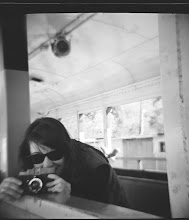48 pages plus cover, perfect bound, 8x10" finished size
Project beginning – 2/17/07
Project complete – 11/20/07
I met my former professor, Corey Postiglione, in snowy NYC last February (’07) to walk the galleries in Chelsea and enjoy some Indian food. We began discussing his upcoming 30-year retrospective show at the Evanston Arts Center in January 2008. He asked me to design the catalog to accompany the show. Additionally, I was to select the images from his entire body of work that were to be included. It was to be a comprehensive review of his work, but not a monograph. A daunting task, considering that I knew Corey, but was not as familiar with the various status positions of his work, i.e., the important pieces.
I began thinking through the various approaches that I could take with this special project. Initially I thought of organizing the work in a traditional, chronological order. But, I really wanted to deliver something special, something unique for my friend’s investment. As we continued our conversation over the months there were two significantly influential experiences that shaped this process. One was a weeklong workshop at the School of Visual Arts with Milton Glaser that I attended. During that week, I was looking at a book that Milton had put together of his drawings, and talking with him about the process for selecting images and composing the book. He said that in his book, he wanted it to read like music flows. From that discussion, I realized that there was no way I could organize the work in Corey’s book chronologically. I wanted to tell a story with his work.
The second influence in this process was my reading John Berger’s The Shape of a Pocket. In the book is an exchange between Berger and Leon Kossof, discussing the model for his drawings and the relationship that has grown as this model came to his studio day in and day out. This exchange resonated with me because in an earlier conversation, Corey had indicated that his body of work had cycled from abstract to figurative and then back to abstract. I noted that throughout Corey’s body of work, the city of Chicago was a constant and central feature, whether the work was abstract or figurative. Initially, these seem like distant connections. But through this excerpt, I began to see the city in Corey’s work as his model. The entity that inspires, frustrates, and intrigues…just like a model.
A few weeks later, I met with Corey in Chicago to finalize the selected images. It was at this meeting that the concept for his catalog really took shape. We agreed to treat the City like a human model and associated human emotions with his relationship to the City and his body of work. Hence, the Discovery, Intimacy, and Anxiety structure. This allowed me to organize the images by sensibility rather than date of completion. Ultimately, this was what I wanted to deliver, a challenge to the reader to explore Corey’s work in ways they previously had not. I wanted the reader to look past the initial beauty and narrative of the work, and search for an understanding of why certain pieces were grouped together.
The Discover
 y section of the catalog includes all of the paradigm pieces – sketches or works that launched an entire series, or epiphany pieces – the moment of really seeing something that you’ve been looking at for years. The Intimacy section includes the pieces within a series in which the artist is trying to understand his subject from every possible vantage point. The Anxiety section includes works that are somewhat ominous in narrative and sensibility. There’s a desire with these pieces to recapture that moment of discovery, and a sense of insecurity.
y section of the catalog includes all of the paradigm pieces – sketches or works that launched an entire series, or epiphany pieces – the moment of really seeing something that you’ve been looking at for years. The Intimacy section includes the pieces within a series in which the artist is trying to understand his subject from every possible vantage point. The Anxiety section includes works that are somewhat ominous in narrative and sensibility. There’s a desire with these pieces to recapture that moment of discovery, and a sense of insecurity.I kept the design
 minimal, maximized the images and anchored them to the outside edge of the page so that nothing would be lost in the gutter. We used McCoy Silk for the paper to mimic the bright white walls of a gallery.
minimal, maximized the images and anchored them to the outside edge of the page so that nothing would be lost in the gutter. We used McCoy Silk for the paper to mimic the bright white walls of a gallery. 


